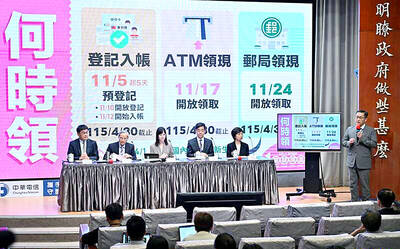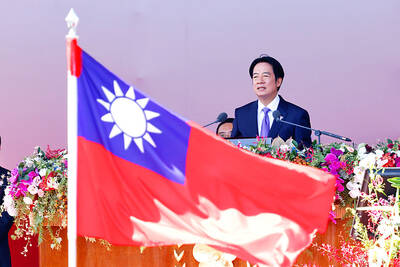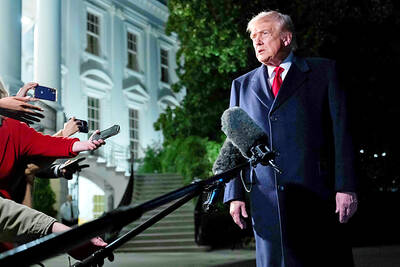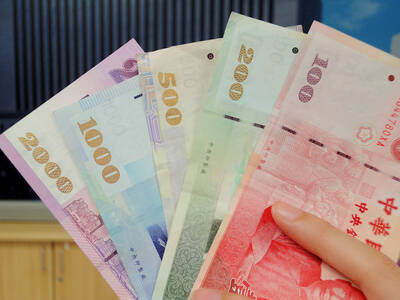An unprecedented rescue plan for the financial system, pending imminent approval by Congress, could stabilize fragile markets, but also poses some risks of its own, analysts said.
The plan, worth up to US$700 billion, would be the largest government economic intervention since the Great Depression of the 1930s, and aims to steady an economy reeling from a burst US housing bubble that has ravaged the global banking system and dried up credit flows.
The plan “will provide some critical life support for the US financial system,” said Brian Bethune, economist at the research firm Global Insight.

PHOTO: AP
Bethune said the modified program, hammered out over more than a week of tense negotiations, “represents a reasonable compromise that more aggressively protects the interests of the American taxpayer.”
According to draft legislation, the Troubled Asset Relief Program would allow the government to buy up troubled assets from banks, pension plans, local governments and other firms. The first installment of US$250 billion could be boosted to a total of as much as US$700 billion.
Four separate oversight agencies or processes, including a presence in the Treasury office, would be set up to conduct audits and prevent fraud, as well as an independent inspector general to monitor the Treasury secretary’s actions.
It would also give taxpayers an ownership stake and chances to share in any future profits of participating companies, limit compensation payments for company executives and allow the government to help prevent home foreclosures. Some analysts remained skeptical about the deal — whether it would work or create new problems for markets and the economy.
David Kotok, chief investment officer at Cumberland Advisors, said he had been in favor of the original rescue plan but had doubts after tinkering by lawmakers, adding it could make it harder to emerge with a healthy banking sector needed for the economy.
“If you impose too much regulation, too much supervision, too much management and too much cost, you damage the franchise and profit outlook for banks,” he said. “If market figures out this is a bad bill, the markets will go south, not north.”
Peter Cohan, a consultant with Peter Cohan & Associates, said he believed “the market should react positively in the short term” and that “the most severe reaction would be if there was no deal.”
But Cohan said the program does nothing to deal with the immediate problem of banks freezing up lending among themselves, which has pushed up key interest rates and led to a squeeze in credit.
“The reason the banks don’t want to lend is because they don’t believe the other banks will pay them back,” he said.
It remained unclear how many banks will participate in the program because of the “disincentives” of limits on executive pay and the prices to be paid for bad mortgage debt, Cohan said.
The prospects for the plan, he said, are “overly optimistic unless the Treasury decides to buy the toxic waste at a price above their book values, but it would stick the taxpayers for a loss.”
Economist Ethan Harris at Barclays Capital said that the government’s best chance of stabilizing the economy and markets would be a “shock and awe” program instead of an incremental approach.
“The inconvenient truth is that for a bailout to work, it must put significant taxpayer money at risk. The piecemeal approach of reacting to individual financial firm failures has slowed, but not stopped, the erosion of confidence in the capital markets,” Harris said.

People can preregister to receive their NT$10,000 (US$325) cash distributed from the central government on Nov. 5 after President William Lai (賴清德) yesterday signed the Special Budget for Strengthening Economic, Social and National Security Resilience, the Executive Yuan told a news conference last night. The special budget, passed by the Legislative Yuan on Friday last week with a cash handout budget of NT$236 billion, was officially submitted to the Executive Yuan and the Presidential Office yesterday afternoon. People can register through the official Web site at https://10000.gov.tw to have the funds deposited into their bank accounts, withdraw the funds at automated teller

PEACE AND STABILITY: Maintaining the cross-strait ‘status quo’ has long been the government’s position, the Ministry of Foreign Affairs said Taiwan is committed to maintaining the cross-strait “status quo” and seeks no escalation of tensions, the Ministry of Foreign Affairs (MOFA) said yesterday, rebutting a Time magazine opinion piece that described President William Lai (賴清德) as a “reckless leader.” The article, titled “The US Must Beware of Taiwan’s Reckless Leader,” was written by Lyle Goldstein, director of the Asia Program at the Washington-based Defense Priorities think tank. Goldstein wrote that Taiwan is “the world’s most dangerous flashpoint” amid ongoing conflicts in the Middle East and Russia’s invasion of Ukraine. He said that the situation in the Taiwan Strait has become less stable

REASSURANCE: The US said Taiwan’s interests would not be harmed during the talk and that it remains steadfast in its support for the nation, the foreign minister said US President Donald Trump on Friday said he would bring up Taiwan with Chinese President Xi Jinping (習近平) during a meeting on the sidelines of the APEC Summit in South Korea this week. “I will be talking about Taiwan [with Xi],” Trump told reporters before he departed for his trip to Asia, adding that he had “a lot of respect for Taiwan.” “We have a lot to talk about with President Xi, and he has a lot to talk about with us. I think we’ll have a good meeting,” Trump said. Taiwan has long been a contentious issue between the US and China.

FRESH LOOK: A committee would gather expert and public input on the themes and visual motifs that would appear on the notes, the central bank governor said The central bank has launched a comprehensive redesign of New Taiwan dollar banknotes to enhance anti-counterfeiting measures, improve accessibility and align the bills with global sustainability standards, Governor Yang Chin-long (楊金龍) told a meeting of the legislature’s Finance Committee yesterday. The overhaul would affect all five denominations — NT$100, NT$200, NT$500, NT$1,000 and NT$2,000 notes — but not coins, Yang said. It would be the first major update to the banknotes in 24 years, as the current series, introduced in 2001, has remained in circulation amid rapid advances in printing technology and security standards. “Updating the notes is essential to safeguard the integrity